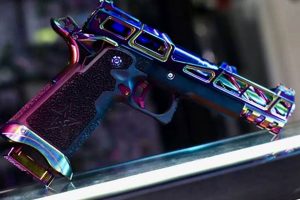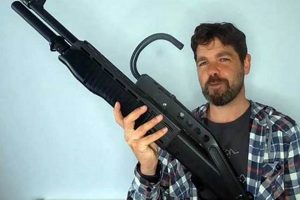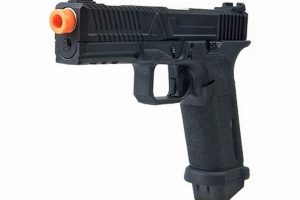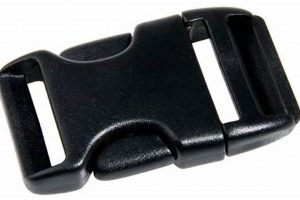The longevity of airsoft sidearms is a concern for players, particularly those new to the sport. The frequency with which these devices require repair or replacement is influenced by various factors. These include the make and model of the pistol, the materials used in its construction, the frequency of use, and the level of maintenance performed.
The durability of an airsoft pistol significantly impacts a player’s experience and investment. A more resilient pistol reduces the need for frequent repairs, minimizes downtime during gameplay, and offers a better overall return on investment. Historically, airsoft pistol construction has evolved from predominantly plastic components to incorporating more robust materials such as metal alloys to enhance lifespan. Proper maintenance, including regular cleaning and lubrication, is crucial in mitigating wear and tear and preventing premature failure.
This article will delve into the common causes of malfunctions in airsoft pistols, examine differences in durability between various types and brands, offer advice on preventative maintenance strategies, and provide guidance on selecting more robust models to minimize the likelihood of needing repairs.
Minimizing Airsoft Pistol Breakdowns
These tips are designed to reduce the likelihood of malfunctions and extend the lifespan of airsoft pistols, mitigating the need for frequent repairs or replacements.
Tip 1: Select Reputable Brands: Research and invest in airsoft pistols manufactured by well-known and trusted brands. These companies often adhere to higher quality control standards and utilize more durable materials, leading to increased reliability.
Tip 2: Choose Appropriate Materials: Consider airsoft pistols constructed with metal alloy components, particularly for critical parts such as the slide, frame, and internal mechanisms. Metal parts are generally more resistant to wear and tear compared to plastic alternatives.
Tip 3: Implement Regular Cleaning: Regularly disassemble and clean the airsoft pistol, removing any dirt, debris, or residue that may accumulate during use. This prevents obstructions and ensures smooth operation of internal parts.
Tip 4: Lubricate Moving Parts: Apply silicone-based lubricant to all moving parts of the airsoft pistol, including the slide, trigger mechanism, and magazine release. This reduces friction and prevents premature wear on critical components.
Tip 5: Use Quality Ammunition: Employ high-quality BBs specifically designed for airsoft pistols. Inferior BBs may be inconsistent in size and shape, leading to jams, misfeeds, and potential damage to the internal mechanisms.
Tip 6: Store Pistols Properly: When not in use, store airsoft pistols in a clean, dry environment, away from direct sunlight and extreme temperatures. This prevents degradation of materials and protects against corrosion.
Tip 7: Avoid Overloading Magazines: Do not exceed the recommended capacity when loading magazines. Overloading can strain the magazine spring and feeding mechanism, potentially leading to malfunctions or damage.
By adhering to these preventative measures, individuals can significantly reduce the risk of experiencing breakdowns with their airsoft pistols, maximizing their performance and lifespan.
The following sections will provide more in-depth analyses of specific failure points and advanced maintenance techniques.
1. Material Composition
The materials used in the construction of airsoft pistols are a critical determinant of their durability and susceptibility to failure. Models constructed primarily of plastic, particularly those employing low-grade polymers, exhibit a significantly higher propensity for breakage compared to those featuring metal alloys. This disparity stems from the inherent mechanical properties of each material. Plastic components are more vulnerable to stress fractures, impact damage, and deformation under prolonged use. For instance, a plastic slide on a gas blowback pistol is more likely to crack or break under the repeated stress of cycling than a comparable slide made of aluminum alloy or steel.
Metal alloys, such as aluminum, zinc, and steel, provide enhanced resistance to these stressors. Aluminum alloys offer a good balance between weight and strength, making them a common choice for slides and frames. Zinc alloys, while more affordable than aluminum, are often less durable and more prone to cracking. Steel components are typically reserved for critical internal parts that experience high stress, such as gears and hammers, where longevity is paramount. A real-world example is the failure of plastic hop-up units in cheaper models, which often crack under the pressure of adjusting the hop-up, leading to inconsistent BB trajectory and requiring replacement. Upgrading to a metal hop-up unit eliminates this weakness and extends the lifespan of the pistol.
Understanding the material composition of an airsoft pistol is therefore essential for predicting its long-term reliability. While plastic components may reduce the initial cost, the increased risk of breakage can lead to higher overall expenses due to frequent repairs or replacements. Selecting models with a higher proportion of metal components, particularly in areas subject to high stress, is a proactive strategy for minimizing downtime and ensuring a more durable and dependable airsoft pistol. The relationship between material composition and failure rates is clear, and prioritizing robust materials is a key factor in mitigating the problem.
2. Usage Frequency
The frequency with which an airsoft pistol is used directly impacts its likelihood of failure. Increased usage translates to greater cumulative stress on internal components, accelerating wear and tear. Each firing cycle subjects the pistol’s mechanisms to pressure, friction, and impact. The more frequent these cycles, the sooner components such as springs, seals, and gears degrade, increasing the probability of malfunctions.
The intensity of use also plays a crucial role. A pistol used in short, infrequent skirmishes will likely experience fewer issues than one employed in prolonged, continuous gameplay. For example, a sidearm carried as a backup and rarely fired during a weekend game is subjected to significantly less stress than a primary pistol used extensively in high-volume shooting scenarios. Consider a gas blowback pistol used heavily during a MilSim event. The rapid cycling of the slide, combined with extended periods of high gas pressure, can lead to premature wear on the nozzle, piston head, and magazine seals. Without proper maintenance between games, these components may fail sooner than expected, resulting in gas leaks, inconsistent firing, or complete mechanical failure.
Understanding the direct correlation between usage frequency and the potential for breakdowns allows players to make informed decisions regarding maintenance schedules and replacement parts. Frequent users should implement more rigorous cleaning and lubrication protocols to mitigate wear. Recognizing the potential for increased stress on internal components allows for proactive replacement of wear items, such as springs and O-rings, before they fail completely. This preventative approach extends the lifespan of the airsoft pistol and minimizes downtime during gameplay. In summary, higher usage rates directly contribute to a higher likelihood of mechanical issues; proactive maintenance is essential to mitigate this effect.
3. Maintenance Practices
Consistent and thorough maintenance practices are integral to the longevity and reliable operation of airsoft pistols. Neglecting routine maintenance significantly increases the likelihood of malfunctions and shortens the lifespan of these devices.
- Regular Cleaning and Lubrication
Accumulation of dirt, debris, and spent lubricant within the internal mechanisms of an airsoft pistol contributes to increased friction and accelerated wear. Regular cleaning with appropriate solvents removes these contaminants, while proper lubrication with silicone-based products reduces friction between moving parts. Failure to clean and lubricate leads to increased stress on components, raising the probability of mechanical failure. For example, a dry or contaminated piston seal in a gas blowback pistol will degrade rapidly, resulting in gas leaks and reduced performance.
- Inspection for Wear and Damage
Routine inspection of critical components, such as O-rings, springs, and gears, allows for the early detection of wear or damage. Identifying and replacing worn parts before they fail prevents cascading damage to other components. Neglecting this aspect allows minor issues to escalate into major malfunctions. A cracked nozzle in a gas blowback system, if left unaddressed, can lead to significant gas leakage and potential damage to the hop-up unit.
- Proper Storage Techniques
Incorrect storage conditions, such as exposure to humidity or extreme temperatures, can degrade the materials used in airsoft pistol construction. Storing pistols in a cool, dry environment, away from direct sunlight, minimizes the risk of corrosion, warping, and material degradation. Failure to do so can compromise the integrity of seals, weaken plastic components, and accelerate the deterioration of internal mechanisms.
- Adherence to Manufacturer Guidelines
Manufacturer guidelines provide specific recommendations for maintenance procedures, lubricant types, and disassembly techniques. Deviating from these guidelines or using inappropriate products can damage sensitive components and void warranties. Following the manufacturer’s instructions ensures that maintenance is performed correctly and minimizes the risk of accidental damage. Incorrect lubrication with petroleum-based products, for example, can cause swelling and degradation of rubber seals.
The consistent application of these maintenance practices significantly reduces the probability of airsoft pistol malfunctions and extends the lifespan of these devices. Neglecting maintenance creates a predictable pathway to increased failure rates and higher repair costs. Prioritizing proper care and attention is essential for ensuring the reliable performance and longevity of airsoft pistols.
4. Brand Reputation
The correlation between brand reputation and the reliability of airsoft pistols is significant. Established brands often invest in rigorous quality control processes, employ higher-grade materials, and adhere to stringent manufacturing standards. Consequently, airsoft pistols from reputable manufacturers tend to exhibit a lower frequency of malfunctions compared to lesser-known or unbranded alternatives. The brand’s reputation serves as an indicator of expected performance and durability, reflecting the manufacturer’s commitment to producing reliable products. For instance, a brand known for its meticulous attention to detail and durable construction is less likely to release pistols with inherent design flaws or substandard components that contribute to frequent breakdowns.
Conversely, brands with limited experience, inconsistent manufacturing practices, or a focus solely on cost reduction may compromise quality, resulting in pistols prone to premature failure. These pistols often utilize cheaper materials and less precise assembly techniques, increasing the risk of mechanical issues. A practical example is the prevalence of stripped gears and broken nozzles in airsoft pistols from manufacturers that prioritize profit margins over product quality. The understanding of brand reputation as a contributing factor to airsoft pistol reliability is crucial for making informed purchasing decisions. Selecting a reputable brand provides a degree of assurance regarding the pistol’s expected performance and longevity.
In summary, brand reputation serves as a reliable, although not infallible, predictor of airsoft pistol durability. Investing in pistols from established manufacturers with a proven track record of quality and reliability can significantly reduce the likelihood of frequent breakdowns and enhance the overall airsoft experience. However, brand reputation alone is not a guarantee of flawless performance, and consideration should also be given to specific model reviews, user feedback, and adherence to proper maintenance practices. The understanding of brand reputation should be used as the basic foundation before purchasing an airsoft pistol.
5. Internal Stress
Internal stress within airsoft pistols directly contributes to their failure rates. This stress manifests through several mechanisms inherent in the operation of these devices. Gas-powered pistols, for example, experience repeated high-pressure cycles that exert significant force on internal components such as nozzles, pistons, and seals. Spring-powered pistols undergo similar stress as springs compress and release, transferring force to sears, pistons, and gearboxes in automatic electric pistols (AEPs). This repeated exertion of force leads to fatigue, weakening materials over time and increasing the susceptibility to fracture or deformation. The degree of internal stress is further influenced by factors such as operating pressure, spring strength, and the quality of materials used in construction. For instance, an airsoft pistol modified to operate at a higher gas pressure than its design specification will experience amplified stress, accelerating wear and significantly increasing the likelihood of failure. This modification can manifest in cracked slides, ruptured gas reservoirs, or shattered internal mechanisms.
One specific example illustrating the impact of internal stress involves the hop-up unit, a component crucial for adjusting BB trajectory. The hop-up unit is often constructed from plastic, and the adjustment mechanism applies pressure to a rubber bucking. Over time, the repeated stress of adjusting the hop-up, combined with the pressure from the BBs passing through, can cause the plastic hop-up unit to crack or warp, leading to inconsistent BB trajectory and decreased accuracy. Upgrading to a metal hop-up unit mitigates this issue by providing greater resistance to deformation and fracture under stress. Furthermore, improperly maintained gas magazines can contribute to increased internal stress. Overfilling magazines or using incorrect gas types can result in excessive pressure buildup, straining the magazine’s seals and potentially causing them to fail, leading to gas leaks and inconsistent performance. The practical significance of understanding internal stress lies in the ability to proactively mitigate its effects through responsible usage, proper maintenance, and the selection of durable materials.
In conclusion, internal stress plays a critical role in the overall reliability of airsoft pistols. The repeated forces generated during operation lead to material fatigue and eventual failure. By understanding the sources of internal stress and taking steps to mitigate its impact, such as using appropriate operating pressures, maintaining proper lubrication, and selecting models constructed from robust materials, individuals can significantly reduce the likelihood of malfunctions and extend the lifespan of their airsoft pistols. Ignoring the effects of internal stress invariably leads to increased failure rates and diminished performance, emphasizing the importance of proactive measures in managing this factor.
6. Ammunition Quality
The quality of ammunition used in airsoft pistols is a significant factor influencing the frequency of malfunctions and potential damage. Utilizing substandard BBs can lead to a cascade of issues that contribute to premature wear and increased failure rates. The inherent design of airsoft pistols requires consistent BB dimensions and surface finish for proper function; deviations from these standards can disrupt the firing cycle and damage internal components.
- Inconsistent BB Size and Shape
BBs with inconsistent diameters or irregular shapes can cause jams within the magazine, barrel, and hop-up unit. These jams disrupt the smooth feeding and firing process, placing undue stress on the pistol’s internal mechanisms. For example, a BB that is slightly larger than the barrel diameter can become lodged, potentially damaging the barrel lining or hop-up bucking as subsequent BBs are forced against it. Repeated jams of this nature can lead to accelerated wear and eventual failure of the affected components. The use of precision BBs helps mitigate this issue.
- Poor Surface Finish
BBs with rough or uneven surfaces increase friction within the barrel and hop-up unit. This heightened friction reduces the velocity of the BB and affects its trajectory. More importantly, the abrasive surface can cause wear on the barrel lining and hop-up bucking over time, reducing their effectiveness and potentially leading to inconsistent performance or complete failure. Using polished BBs minimizes friction and reduces the risk of abrasive wear. Low-quality BBs often have visible seams or imperfections.
- Material Degradation
Low-quality BBs may be made from inferior plastics that degrade or shatter upon impact or within the pistol itself. These fragments can accumulate within the internal mechanisms, causing obstructions and interfering with the proper functioning of the firing cycle. The debris can also damage seals, gears, and other sensitive components, leading to malfunctions and reducing the overall lifespan of the pistol. The selection of biodegradable or high-density plastic BBs can minimize the risk of fragmentation and subsequent damage.
- Incompatible Weight
Using BBs that are too heavy or too light for a particular airsoft pistol can also contribute to increased wear. BBs that are too heavy can place undue stress on the hop-up unit and internal mechanisms, while BBs that are too light may not generate sufficient backspin, leading to poor accuracy and increased strain on the system. The appropriate BB weight is specified for each airsoft pistol, and adhering to these guidelines is crucial for optimal performance and longevity.
The cumulative effect of using low-quality ammunition manifests as increased maintenance requirements, reduced accuracy, and a higher probability of mechanical failures in airsoft pistols. Selecting high-quality BBs that are consistent in size, shape, and material composition is a simple yet effective measure for minimizing these risks and extending the operational lifespan of these devices. Neglecting ammunition quality, conversely, becomes a direct contributor to the problem of frequent airsoft pistol breakdowns.
7. Storage Conditions
The conditions under which airsoft pistols are stored significantly impact their durability and contribute to the frequency of malfunctions. Improper storage can accelerate material degradation, promote corrosion, and compromise the integrity of internal mechanisms, ultimately leading to an increased likelihood of breakdowns.
- Humidity Exposure
Elevated humidity levels promote corrosion on metallic components, including barrels, internal mechanisms, and magazines. Rust formation weakens these parts, increasing the risk of failure or jamming. The accumulation of moisture can also degrade seals and O-rings, leading to gas leaks and reduced performance in gas-powered pistols. Storing airsoft pistols in a dry environment, preferably with desiccant packs, mitigates these risks. For example, storing a pistol in a damp basement or garage without protection significantly accelerates corrosion compared to storing it in a climate-controlled room.
- Temperature Fluctuations
Extreme temperature variations, particularly frequent cycling between hot and cold, can cause expansion and contraction of materials, leading to stress fractures and warping. Plastic components are particularly vulnerable to deformation under high temperatures, while rapid cooling can embrittle certain materials. Storing airsoft pistols in a location with stable temperature conditions minimizes these effects. Leaving a pistol in a vehicle on a hot day, for instance, can cause irreversible damage to plastic parts and compromise its overall functionality.
- Direct Sunlight Exposure
Prolonged exposure to direct sunlight can degrade plastic and rubber components due to ultraviolet (UV) radiation. UV radiation causes discoloration, embrittlement, and cracking of these materials, weakening their structural integrity and increasing the risk of failure under stress. Storing airsoft pistols away from direct sunlight or using protective cases with UV-resistant materials prevents this degradation. Leaving a pistol on a sunny windowsill, for example, accelerates the aging process and reduces its operational lifespan.
- Physical Protection
Improper storage can expose airsoft pistols to physical damage from impacts, crushing forces, or abrasion. Storing pistols loosely in a container or allowing them to come into contact with other hard objects increases the risk of scratches, dents, and broken components. Using dedicated cases or padded compartments provides physical protection during storage and transportation. For instance, tossing a pistol into a gear bag without any padding significantly increases the risk of damage compared to storing it in a fitted case with foam inserts.
The cumulative effect of these storage-related factors directly influences the frequency with which airsoft pistols break down. By implementing appropriate storage practices, such as controlling humidity, maintaining stable temperatures, avoiding direct sunlight, and providing physical protection, individuals can significantly reduce the risk of material degradation and component failure, thereby extending the lifespan and enhancing the reliability of their airsoft pistols. Neglecting these considerations exacerbates the likelihood of malfunctions and contributes to the common concern regarding the durability of these devices.
Frequently Asked Questions
This section addresses common queries regarding the reliability and potential for malfunctions in airsoft pistols, providing clear and informative answers to prevalent concerns.
Question 1: What are the most common causes of airsoft pistol failure?
Malfunctions typically arise from material fatigue due to repeated stress, inadequate maintenance leading to corrosion or component wear, use of low-quality ammunition causing jams and internal damage, and improper storage conditions promoting material degradation.
Question 2: Are gas blowback pistols inherently more prone to breakage than other types?
Gas blowback pistols involve more complex internal mechanisms and higher operating pressures, increasing the potential for component stress and wear. However, the quality of materials and adherence to proper maintenance practices are ultimately more significant determinants of reliability than the operating mechanism alone.
Question 3: How does brand reputation influence the likelihood of airsoft pistol failure?
Established brands often employ higher quality control standards and utilize more durable materials, resulting in a lower probability of malfunctions compared to lesser-known or unbranded alternatives. Brand reputation serves as an indicator of expected performance and durability.
Question 4: Does the weight of the BB used affect the lifespan of an airsoft pistol?
Using BBs that are significantly heavier or lighter than the manufacturer’s recommended weight range can place undue stress on the internal mechanisms, particularly the hop-up unit and piston. This can accelerate wear and increase the risk of component failure.
Question 5: Is it possible to extend the lifespan of an airsoft pistol through regular maintenance?
Implementing consistent and thorough maintenance practices, including regular cleaning, lubrication, and inspection for wear or damage, is critical for maximizing the lifespan and reliable operation of airsoft pistols. Neglecting maintenance significantly increases the probability of malfunctions.
Question 6: Are airsoft pistol repairs typically complex and expensive?
The complexity and cost of repairs vary depending on the nature of the malfunction and the pistol’s design. Some minor issues can be resolved with simple adjustments or replacement of readily available parts. However, more extensive damage may require specialized tools and expertise, leading to higher repair costs.
Understanding the factors that contribute to airsoft pistol malfunctions and implementing preventative measures is crucial for ensuring their reliable performance and extending their operational lifespan. Prioritizing quality, maintenance, and proper usage significantly reduces the likelihood of frequent breakdowns.
The following section will address selection criteria to consider when purchasing an airsoft pistol.
Airsoft Pistol Reliability
The investigation into airsoft pistol durability reveals a complex interplay of factors that determine the frequency of malfunctions. Material composition, usage frequency, maintenance practices, brand reputation, internal stress, ammunition quality, and storage conditions all significantly contribute to the operational lifespan of these devices. The assessment establishes that while the inherent design and operating mechanisms of airsoft pistols can make them susceptible to wear and tear, proactive measures can substantially mitigate the risk of breakdowns.
Recognizing the multifaceted nature of airsoft pistol reliability enables informed decision-making. Prioritizing quality materials, implementing diligent maintenance routines, and adhering to responsible usage protocols are essential for maximizing the performance and longevity of these devices. The potential for malfunctions should not deter engagement with the sport, but rather inform a strategic approach to ownership and care. Further research and continuous refinement of maintenance techniques will further contribute to minimizing the issue.







